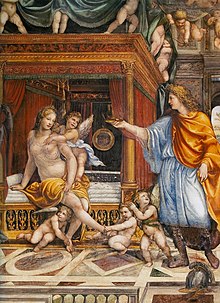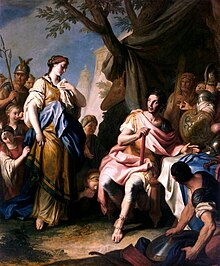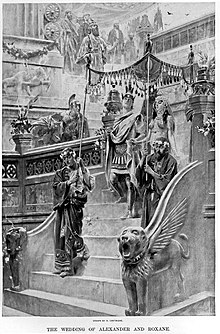Roxana
You can help expand this article with text translated from the corresponding article in German. (April 2017) Click [show] for important translation instructions.
|
| Roxana | |
|---|---|
 Marriage of Alexander and Roxana by Il Sodoma | |
| Born | c. 340 BC Sogdia or Bactria |
| Died | 310 BC Amphipolis, Macedon, Ancient Greece |
| Spouse | Alexander the Great |
| Issue | Alexander IV |
| Father | Oxyartes |
| Religion | Zoroastrianism |
Roxana (c. 340 BC – 310 BC,[1] Ancient Greek: Ῥωξάνη; Old Iranian: *Raṷxšnā- "shining, radiant, brilliant"; sometimes Roxanne, Roxanna, Rukhsana, Roxandra and Roxane) was a Sogdian[2][3] or a Bactrian[4] princess whom Alexander the Great married after defeating Darius, ruler of the Achaemenid Empire, and invading Persia. The exact date of her birth is unknown, but she was probably in her late teens or early twenties at the time of her wedding to Alexander the Great.[3]


Biography
Roxana was born in c. 340 BC as the daughter of a Bactrian nobleman named Oxyartes who served Bessus, the satrap of Bactria and Sogdia.[1] He was thus probably also involved in the murder of the last Achaemenid king Darius III. After Bessus was captured by the Macedonian ruler Alexander the Great, Oxyartes and his family continued to resist the Macedonians, and along with other notables such as the Sogdian warlord Spitamenes, took up a defensive position in a fortress known as the Sogdian Rock.[5]
They were eventually defeated by Alexander, who attended a celebration,[6] and reportedly fell in love with Roxana on sight.[7] Where the celebration took place, if in the Sogdian Rock or another fortress of Chorienes (also called Sisimithres by Quintus Rufus Curtius) during which Alexander met Roxana[6] but according to the Metz Epitome it was in the house of Chorienes in which Roxana was introduced to Alexander as the daughter of Oxyartes.[8][6] In 327 BC, Alexander married Roxana despite opposition from his companions and generals.[9] The marriage was also of political advantage as it made the Sogdian army more loyal towards Alexander and less rebellious after their defeat.[10] Alexander thereafter made an expedition into India and while there he appointed Oxyartes as the governor of the Hindu Kush region which was adjoining India.[1] It is assumed that during this period, Roxana was in a safe place in Susa.[1] When Alexander returned to Susa, he promoted a brother of Roxana to the elite cavalry.[5][1] With the aim of a better acceptance of his government among the Persians, Alexander also married Stateira II, the daughter of the deposed Persian King Darius III.[1]
After Alexander's sudden death at Babylon in 323 BC, Roxana is believed to have murdered Alexander's other widow, Stateira II, and possibly Stateira's sister, Drypetis,[11] and her cousin, Parysatis II (Alexander's third wife). Roxana's unborn child caused some discussions between Alexander's loyalists around Perdiccas[12] and Ptolemy[13] who suggested to await Alexander's child to be the next King and name either a caretaker regent or a council in his stead, and the Macedonian soldiers who opposed a so-called persianization of the Macedonian court.[12] For the Macedonian succession a temporary compromise was found as Arrhidaeus was declared Macedonian King; if the unborn child was a son, he was to become a King as well.[14] By 317 though, Roxana's son, called Alexander IV lost his right to be king due to intrigues started by the Philip Arrhidaeus' wife, Eurydice II.[1] Afterwards Roxana and her son were protected by Alexander's mother, Olympias, in Macedonia.[15] Following Olympias' assassination in 316 BC Cassander imprisoned Roxana and Alexander IV in the citadel of Amphipolis.[16] Their detention was condemned by the Macedonian general Antigonus in 315 BC.[17] In 311 BC a peace treaty between Antigonus and Cassander confirmed the Kingship of Alexander IV but also Cassander as his guardian,[17] following which the Macedonians demanded his release.[18] However, Cassander ordered Glaucias to kill Alexander and Roxana.[19] It is assumed that they were murdered in spring 310 BC, but their death was concealed until the summer.[20] The two were killed after Heracles, a son of Alexander the Great's mistress Barsine, was murdered, bringing the Argead dynasty to an end.[16]
Honors
Asteroid 317 Roxane is named in her honor.[21]
See also
- Alexandre et Roxane, an opera that Mozart planned to write
- Balkh
- Roshanak
References
- ^ a b c d e f g Badian, Ernst. "Welcome to Encyclopaedia Iranica". iranicaonline.org. Encyclopedia Iranica. Retrieved 23 November 2021.
{{cite web}}: CS1 maint: url-status (link) - ^ Ahmed, S. Z. (2004). Chaghatai: the Fabulous Cities and People of the Silk Road. West Conshokoken: Infinity Publishing. p. 61.
- Strachan, Edward; Bolton, Roy (2008). Russia and Europe in the Nineteenth Century. London: Sphinx Fine Art. p. 87. ISBN 978-1-907200-02-1.
- Ramirez-Faria, Carlos (2007). Concise Encyclopedia of World History. New Delhi: Atlantic Publishers & Distributors. p. 450. ISBN 978-81-269-0775-5. - ^ a b Christopoulos, Lucas (August 2012). Mair, Victor H. (ed.). "Hellenes and Romans in Ancient China (240 BC – 1398 AD)" (PDF). Sino-Platonic Papers (230). Chinese Academy of Social Sciences, University of Pennsylvania Department of East Asian Languages and Civilizations: 4. ISSN 2157-9687.
- ^ "Roxana". Encyclopædia Britannica. 6 November 2019. Retrieved 10 October 2019.
- Schmitt, Rüdiger (20 July 2002). "OXYARTES". Encyclopædia Iranica. Retrieved 10 October 2019.
- Strabo 11.11.4.
- Rawlinson, Hugh G. (1912). Bactria, the History of a Forgotten Empire.[page needed] - ^ a b Badian 2015.
- ^ a b c Bosworth, A. B. (1981). "A Missing Year in the History of Alexander the Great". The Journal of Hellenic Studies. 101: 31. doi:10.2307/629841. ISSN 0075-4269. JSTOR 629841. S2CID 161365503.
- ^ Horn & Spencer 2012, p. 40.
- ^ Chaumont, Marie-Louise. "Welcome to Encyclopaedia Iranica". Encyclopædia Iranica. Retrieved 11 February 2022.
- ^ Young, Andrew (2014),p.145
- ^ Young, Andrew (2014). The Lost Book of Alexander the Great. Westholme Publishing. pp. 144–145. ISBN 978-1-59416-197-1.
- ^ Plutarch. Alex. 77.4
- ^ a b Anson, Edward M. (14 July 2014). Alexander's Heirs: The Age of the Successors. John Wiley & Sons. pp. 14–17. ISBN 978-1-4443-3962-8.
- ^ Anson, Edward M. (14 July 2014), pp.16–17
- ^ Anson, Edward M. (14 July 2014), pp.20–21
- ^ Anson, Edward M. (14 July 2014), p.106
- ^ a b Anson, Edward M. (14 July 2014), p.116
- ^ a b Simpson, R. H. (1954). "The Historical Circumstances of the Peace of 311". The Journal of Hellenic Studies. 74: 28. doi:10.2307/627551. ISSN 0075-4269. JSTOR 627551. S2CID 146837142 – via JSTOR.
- ^ Thirlwall, Connop (1840). A History of Greece. Longmans. p. 318.
- ^ Thirlwall, Connop (1840), p.319
- ^ Anson, Edward M. (14 July 2014), p.149
- ^ Schmadel, Lutz D. (2007). "(317) Roxane". Dictionary of Minor Planet Names – (317) Roxane. Springer Berlin Heidelberg. p. 42. doi:10.1007/978-3-540-29925-7_318. ISBN 978-3-540-00238-3.
Sources
- Badian, Ernst (2015). "RHOXANE ii. ALEXANDER'S WIFE". Encyclopædia Iranica. Retrieved 11 March 2021.
- Renault, Mary (2001). The Nature of Alexander the Great. Penguin. ISBN 978-0-14-139076-5.
- Plutarch (1919). Perrin, Bernadotte (ed.). Plutarch, Alexander. Perseus Project. Retrieved 6 December 2011.
- Plutarch (1936). Babbitt, Frank Cole (ed.). On the Fortune of Alexander. Vol. IV. Loeb Classical Library. pp. 379–487. Retrieved 26 November 2011.
- Horn, Bernd; Spencer, Emily, eds. (2012). No Easy Task: Fighting in Afghanistan. Dundurn Press Ltd. p. 40. ISBN 978-1-4597-0164-9.
External links
- Chisholm, Hugh, ed. (1911). . Encyclopædia Britannica (11th ed.). Cambridge University Press.
- Roxane[dead link] by Jona Lendering
- Wiki Classical Dictionary: Roxane, daughter of Oxyartes
- Roxana from Charles Smith's Dictionary of Greek and Roman Biography and Mythology (1867)
- 340s BC births
- 310s BC deaths
- 4th-century BC Iranian people
- 4th-century BC women
- Ancient Macedonian queens consort
- Ancient murder victims
- Bactria
- Iranic women
- Murdered royalty of Macedonia (ancient kingdom)
- People who died under the regency of Cassander
- Sogdian people
- Wives of Alexander the Great
- Women in Hellenistic warfare
- Women of the Achaemenid Empire
